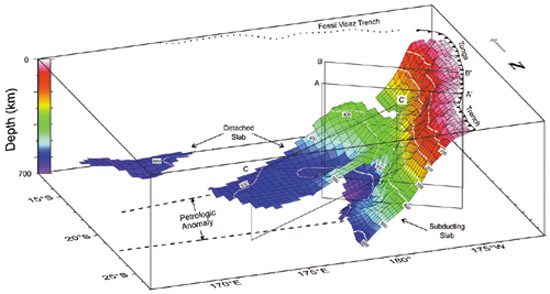Geotimes

News
Notes
Seismology
Buoyant
slabs
A 2,000-kilometer-long slab of unattached lithosphere may be suspended
400 to 600 kilometers below the Fiji islands near the Tonga subduction
zone. It may have broken off from a previous subduction along the now dormant
Vitiaz trench 5 to 8 million years ago, which would indicate that mixing
in the mantle is less dynamic than supposed and pristine lower mantle more
likely to exist.
 [Left:
A 3-D rendition of a detached slab remnant and the actively subducting
lithosphere in the Tonga subduction region constructed from 35 years of
seismic records. The juxtaposition of slabs retains a large amount of subducted
material above the lower mantle. Image credit: Wang-Ping Chen and Michael
Brudzinski]
[Left:
A 3-D rendition of a detached slab remnant and the actively subducting
lithosphere in the Tonga subduction region constructed from 35 years of
seismic records. The juxtaposition of slabs retains a large amount of subducted
material above the lower mantle. Image credit: Wang-Ping Chen and Michael
Brudzinski]
Wang-Ping Chen and Michael Brudzinski of the University of Illinois,
Urbana, presented evidence for the slab in the June 29 Science, adding
fuel to a debate over the interaction between subducted lithosphere and
the transition zone between upper and lower mantle. “Is the whole mantle
churning like soup on the stove or is it moving in layers or what?” says
Harold Green of the University of California, Riverside, and author of
an article in the same issue of Science evaluating Chen and Brudzinski’s
work. “They’ve raised some questions for someone else to chew on.”
Chen and Brudzinski used two pieces of evidence to infer the slab’s
presence. One is the deep earthquakes located near, but not in, Tonga’s
Wadati-Benioff zone (WBZ), where the cold Pacific plate is plunging at
a rapid 2 centimeters per year — five times faster than movement along
the San Andreas fault — underneath the Indo-Australian plate. In addition
to the usual Benioff quakes, data from the last 35 years show a cluster
of earthquakes 300 kilometers deep and several hundred kilometers west
of the WBZ. Another group is located at 500 kilometers depth, 200 kilometers
above the deepest end of the WBZ.
Earthquakes located deeper than 100 kilometers are assumed to take place
in cold subducted lithosphere. But the location and focal mechanism of
these quakes indicate that they are not happening in the actively subducting
Tonga lithosphere.
The second piece of evidence is the slower-than-expected speed of P
and S waves in the region where the unusual earthquakes occur. The speed
of seismic waves at the mantle’s transition zone is constrained mainly
by temperature and petrology. Subducted material is relatively cold and
seismic waves should, therefore, travel faster there than in the surrounding
material. Since they don’t, the authors attribute the relatively slow speeds
to the presence of either subducted metastable olivine or subducted volatiles,
two ingredients that can slow seismic waves and trigger earthquakes. But
because not enough earthquakes occur to “map” the slab, the researchers
used seismic tomography to outline its orientation and size.
Their findings indicate the presence of a remnant slab lying at a low
angle above the active WBZ, which dips steeply at 60 degrees. Although
a solitary slab doesn’t leave much evidence of its origin, the fact that
it overlaps the WBZ makes it difficult to connect it to the subducting
Tonga slab. If it is some kind of remnant from previous subduction
activity, then there is hope that the lower mantle may not have been subject
to the wholesale penetration of subducted lithosphere, Chen says. “The
amount of slab penetration into the lower mantle controls the rate of heat
and mass transfer between the upper and lower mantle,” he explains. “Heat
is getting out of the earth slower than we thought — it’s not a total convective
system. The implications here are that it’s easier to preserve primordial
mantle.”
Chen and Brudzinski’s explanation is not the only one for the slab’s
origin. Green suggests that the buoyant slab could be a piece of subducting
Tonga slab that broke off and rose upward, instead of a piece of older
lithosphere slowly sinking. “Where is the material that has been subducted
down the Tonga subduction zone?” he writes. “The seismogenic zone in the
currently active slab ends at the base of the transition zone (the maximum
limit of earthquake activity worldwide).”
Whatever the answer to the unusual seismicity at Tonga, Green points
out that a slightly sloping slab is much easier to study from the surface
than a steeply sloping slab with no constant depth. And the fact that the
unattached slab was found and tentatively “mapped” shows that scientists
are making leap-frog advances in their exploration of deep mantle conditions,
he says.
Emily D. Johnson
 [Left:
A 3-D rendition of a detached slab remnant and the actively subducting
lithosphere in the Tonga subduction region constructed from 35 years of
seismic records. The juxtaposition of slabs retains a large amount of subducted
material above the lower mantle. Image credit: Wang-Ping Chen and Michael
Brudzinski]
[Left:
A 3-D rendition of a detached slab remnant and the actively subducting
lithosphere in the Tonga subduction region constructed from 35 years of
seismic records. The juxtaposition of slabs retains a large amount of subducted
material above the lower mantle. Image credit: Wang-Ping Chen and Michael
Brudzinski]

